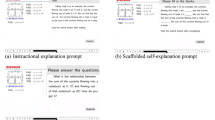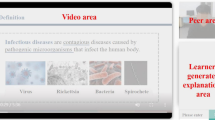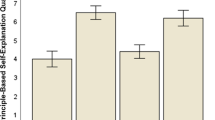Abstract
This study examined the effectiveness of embedding self-regulated learning (SRL) prompts in a video designed for the flipped class model. The sample included 32 undergraduate participants who were randomly assigned to one of two conditions: control (video) or experimental (video + SRL prompts). Prior knowledge was measured with a pre-test, SRL was measured with a concurrent think-aloud, and learning outcomes were measured with a posttest. Results indicated that monitoring of understanding was significantly related to pausing and restarting the video during the learning task. Additionally, participants who receive the embedded prompts in the video engaged in more SRL processes (e.g., activating prior knowledge, monitoring understanding and controlling the video). Furthermore, the embedded prompts enhanced instructional efficiency, as evidenced by the significant difference in learning outcomes and non-significant difference in mental effort.
Similar content being viewed by others
Notes
Directions for learning with the video: You will be asked to learn about motivating students in a classroom by watching a video. The opening part of the video will provide learning objectives to help you prepare for the post-test, which you will take after watching the video. Please engage the video however you would like; that is, you can pause, rewind, fast-forward, take notes, etc. There is no time limit for the video. Please use the objectives provided in the beginning of the video to guide your learning. In order for us to understand how you learn about motivating students, you are asked to “think aloud” continuously while watching the video. Say everything you are thinking and doing while watching the video. I’ll be here in case anything goes wrong with the computer.
References
Anderson, J. R. (1987). Methodologies for studying human knowledge. Behavioral and Brain Sciences, 10, 467–505.
Azevedo, R. (2008). The role of self-regulation in learning about science with hypermedia. In D. Robinson & G. Schraw (Eds.), Recent innovations in educational technology that facilitate student learning (pp. 127–156). Charlotte, NC: Information Age Publishing.
Azevedo, R. (2009). Theoretical, methodological, and analytical challenges in the research on metacognition and self-regulation: A commentary. Metacognition & Learning, 4, 87–95.
Azevedo, R. (2014). Issues in dealing with sequential and temporal characteristics of self-and socially-regulated learning. Metacognition and Learning, 9(2), 217–228.
Azevedo, R., & Cromley, J. G. (2004). Does training on self-regulated learning facilitate students’ learning with hypermedia? Journal of Educational Psychology, 96(3), 523–535.
Azevedo, R., Feyzi-Behnagh, R., Duffy, M., Harley, J., & Trevors, G. (2012). Metacognition and self-regulated learning in student-centered leaning environments. In D. Jonassen & S. Land (Eds.), Theoretical foundations of student-center learning environments (2nd ed., pp. 171–197). New York: Routledge.
Azevedo, R., Johnson, A., Chauncey, A., & Burkett, C. (2010). Self-regulated learning with MetaTutor: Advancing the science of learning with MetaCognitive tools. In M. Khine & I. Saleh (Eds.), New science of learning: Computers, cognition, and collaboration in education (pp. 225–247). Amsterdam: Springer.
Azevedo, R., Witherspoon, A., Chauncey, A., Burkett, C., & Fike, A. (2009). MetaTutor: A metacognitive tool for enhancing self-regulated learning. Paper presented at the Cognitive and metacognitive educational systems: AAAI Fall Symposium.
Bannert, M. (2009). Promoting self-regulated learning through prompts. Zeitschrift für Pädagogische Psychologie, 23(2), 139–145.
Bannert, M., & Reimann, P. (2012). Supporting self-regulated hypermedia through prompts. Instructional Science, 40(1), 193–211.
Bergmann, J., & Sams, A. (2012). Flip your classroom: Read every student in every class every day. Eugene, OR: International Society for Technology in Education.
Boekaerts, M., Pintrich, P., & Zeidner, M. (Eds.). (2000). Handbook of self-regulation. San Diego, CA: Academic Press.
Cleary, T. J., & Platten, P. (2013). Examining the correspondence between self-regulated learning and academic achievement: A case study analysis. Education Research International.
Davies, R. S., Dean, D. L., & Ball, N. (2013). Flipping the classroom and instructional technology integration in a college-level information systems spreadsheet course. Educational Technology Research and Development, 61(4), 563–580.
Eccles, J. S., & Wigfield, A. (2002). Motivational beliefs, values, and goals. Annual Review of Psychology, 53, 109–132.
Enfield, J. (2013). Looking at the impact of the flipped classroom model of instruction on undergraduate multimedia students at CSUN. TechTrends, 57(6), 14–27.
Ericsson, K. A. (2006). Protocol analysis and expert thought: Concurrent verbalizations of thinking during experts’ performance on representative tasks. In K. A. Ericsson, N. Charness, P. J. Feltovich, & R. R. Hoffman (Eds.), The Cambridge handbook of expertise and expert performance (pp. 223–241). New York: Cambridge University Press.
Ericsson, K. A., & Simon, H. A. (1993). Protocol analysis: Verbal reports as data (2nd ed.). Cambridge, MA: MIT Press.
Feyzi-Behnagh, R., Azevedo, R., Legowski, E., Reitmeyer, K., Tseytlin, E., & Crowley, R. S. (2014). Metacognitive scaffolds improve self-judgments of accuracy in a medical intelligent tutoring system. Instructional Science, 42(2), 159–181.
Gerjets, P., Scheiter, K., & Catrambone, R. (2004). Designing instructional examples to reduce intrinsic cognitive load: Molar versus modular presentation of solution procedures. Instructional Science, 32(1), 33–58.
Greene, J. A., & Azevedo, R. (2009). A macro-level analysis of SRL processes and their relations to the acquisition of a sophisticated mental model of a complex system. Contemporary Educational Psychology, 34(1), 18–29.
Hashmi, A. H., & Shih, C. W. (2013). The Harvard classroom, digitized. The Harvard Crimson, 1. http://www.thecrimson.com/article/2013/10/31/harvard-classroom-virtual-learning.
Herreid, C. F., & Schiller, N. A. (2013). Case studies and the flipped classroom. Journal of College Science Teaching, 42(5), 62–66.
Hoffman, B., & Spatariu, A. (2011). Metacognitive prompts and mental multiplication: Analyzing strategies with a qualitative lens. Journal of Interactive Learning Research, 22(4), 607–635.
Ifenthaler, D. (2012). Determining the effectiveness of prompts for self-regulated learning in problem-solving scenarios. Educational Technology & Society, 15(1), 38–52.
Jacobson, M. J., & Archodidou, A. (2000). The design of hypermedia tools for learning: Fostering conceptual change and transfer of complex scientific knowledge. Journal of the Learning Sciences, 9(2), 145–199.
Johnson, A., Azevedo, R., & D’Mello, S. (2011). The temporal and dynamic nature of self-regulatory processes during independent and externally assisted hypermedia learning. Cognition and Instruction, 29(4), 471–504.
Kester, L., Kirschner, P. A., & van Merriënboer, J. J. G. (2005). The management of cognitive load during complex cognitive skill acquisition by means of computer-simulated problem solving. British Journal of Educational Psychology, 75(1), 71–85.
McLaughlin, J. E., Griffin, L. M., Esserman, D. A., Davidson, C. A., Glatt, D. M., Roth, M. T., & Griffin, L. M. (2013). Pharmacy student engagement, performance, and perception in a flipped satellite classroom. American Journal of Pharmaceutical Education, 77(9). doi:10.5688/ajpe779196.
Moos, D. C. (2011). Self-regulated learning and externally generated feedback with hypermedia. Journal of Educational Computing Research, 43(3), 261–294.
Moos, D. C. (2013). Hypermedia learning: Considering cognitive load and self-regulated learning. Journal of Educational Multimedia and Hypermedia, 22(1), 39–61.
Moos, D. C. (2014). Setting the stage for metacognition during hypermedia learning: What motivation constructs matter? Computers & Education, 70, 128–137.
Moos, D. C., & Azevedo, R. (2008). Self-regulated learning with hypermedia: The role of prior domain knowledge. Contemporary Educational Psychology, 33, 270–298.
Moos, D. C., & Stewart, C. (2013). Self-regulated learning with hypermedia: Bringing motivation into the conversation. In R. Azevedo & V. Aleven (Eds.), International handbook of metacognition and learning technologies (pp. 683–697). New York, NY: Springer.
Newell, A., & Simon, H. A. (1972). Human problem solving. Englewood Cliffs, NJ: Prentice-Hall.
Paas, F., Renkl, A., & Sweller, J. (2003). Cognitive load theory and instructional design: Recent developments. Educational Psychologist, 38, 1–4.
Paas, F., Tuovinen, J. E., van Merriënboer, J. J. G., & Darabi, A. A. (2005). A motivational perspective on the relation between mental effort and performance: Optimizing learner involvement in instruction. Educational Technology Research and Development, 53(3), 25–34.
Perry, N. E., & Winne, P. H. (2006). Learning from learning kits: gStudy traces of students’ self-regulated engagements with computerized content. Educational Psychology Review, 18(3), 211–228.
Pintrich, P. (2000). The role of goal orientation in self-regulated learning. In M. Boekaerts, P. Pintrich, & M. Zeidner (Eds.), Handbook of self-regulation (pp. 452–502). San Diego, CA: Academic Press.
Pintrich, P., Smith, D.F., Garcia, T., & McKeachie, W.J. (1991). The manual for the use of the Motivated Strategies for Learning Questionnaire (MSLQ) (Technical Report No. 91-B-004). Ann Arbor: University of Michigan, School of Education.
Pintrich, P., & Zusho, A. (2002). The development of academic self-regulation: The role of cognitive and motivational factors. In A. Wigfield & J. S. Eccles (Eds.), Development of achievement motivation (pp. 249–284). San Diego, CA: Academic Press.
Salomon, G. (1984). Computers in education: Setting a research agenda. Educational Technology, 24, 7–11.
Schunk, D. H., & Mullen, C. A. (2012). Self-efficacy as an engaged learning. In S. L. Christensons, A. L. Reschly, & C. Wylie (Eds.), Handbook of research on student engagement (pp. 219–235). New York, NY: Springer.
Schunk, D. H., & Usher, E. L. (2012). Social cognitive theory and motivation. In R. M. Ryan (Ed.), The Oxford handbook of human motivation (pp. 13–27). New York, NY: Oxford University Press.
Schunk, D. H., & Zimmerman, B. J. (2013). Self-regulation and learning. In W. M. Reynolds, G. E. Miller, & I. B. Weiner (Eds.), Handbook of psychology (educational psychology) (2nd ed., Vol. 7, pp. 45–68). Hoboken, NJ: Wiley.
Shapiro, A. (2008). Hypermedia design as learner scaffolding. Educational Technology Research and Development, 56, 29–44.
Smith, J. D. (2013). Student attitudes toward flipping the general chemistry classroom. Chemistry Education Research Practice, 14(4), 607–614.
Sweller, J. (2004). Instructional design consequences of an analogy between evolution by natural selection and human cognitive architecture. Instructional Science, 32(1/2), 9–31.
Tuysuzoglu, B. B., & Greene, J. A. (2015). An investigation of the role of contingent behavior in self-regulated learning. Metacognition and Learning, 10(1), 77–98.
van Gog, T., Paas, F., & van Merriënboer, J. J. G. (2008). Effects of studying sequences of process-oriented and product-oriented worked examples on troubleshooting transfer efficiency. Learning and Instruction, 18(3), 211–222.
van Merriënboer, J. J. G., & Sweller, J. (2005). Cognitive load theory and complex learning: Recent developments and future directions. Educational Psychology Review, 17, 147–177.
Verhoeven, L., Schnotz, W., & Paas, F. (2009). Cognitive load in interactive knowledge construction. Learning and Instruction, 19, 369–375.
Vukman, K. B. (2005). Developmental differences in metacognition and their connections with cognitive development in adulthood. Journal of Adult Development, 12(4), 211–221.
Weinstein, C. E. (1987). LASSI user’s manual. Clearwater, FL: H & H Publishing.
Winne, P. H. (2001). Self-regulated learning viewed from models of information processing. In B. Zimmerman & D. Schunk (Eds.), Self-regulated learning and academic achievement: Theoretical perspectives (pp. 153–189). Mahwah, NJ: Erlbaum.
Winne, P. (2005). Key issues on modeling and applying research on self-regulated learning. Applied Psychology: An International Review, 54(2), 232–238.
Winne, P., & Hadwin, A. F. (1998). Studying self-regulated learning. In D. J. Hacker, J. Dunlosky, & A. Graesser (Eds.), Metacognition in educational theory and practice (pp. 277–304). Hillsdale, NJ: Erlbaum.
Winne, P. H., & Nesbit, J. C. (2009). Supporting self-regulated learning with cognitive tools. In D. J. Hacker, J. Dunlosky, & A. C. Graesser (Eds.), Handbook of metacognition in education (pp. 259–277). New York: Routledge.
Winne, P. H., & Perry, N. E. (2000). Measuring self-regulated learning. In M. Boekaerts, P. Pintrich, & M. Zeidner (Eds.), Handbook of self-regulation (pp. 531–566). Orlando, FL: Academic Press.
Wirth, J. (2009). Prompting self-regulated learning through prompts. Zeitschrift für Pädagogische Psychologie, 23(2), 91–94.
Zimmerman, B. J. (2001). Theories of self-regulated learning and academic achievement: An overview and analysis. In B. Zimmerman & D. Schunk (Eds.), Self-regulated learning and academic achievement: Theoretical perspectives (pp. 1–37). Mahwah, NJ: Erlbaum.
Zimmerman, B. J. (2006). Development and adaptation of expertise: The role of self-regulatory processes and beliefs. In K. A. Ericsson, N. Charness, P. J. Feltovich, & R. R. Hoffman (Eds.), The Cambridge handbook of expertise and expert performance (pp. 705–722). Cambridge, NY: Cambridge.
Zimmerman, B. (2008). Investigating self-regulation and motivation: Historical background, methodological developments, and future prospects. American Educational Research Journal, 45(1), 166–183.
Zimmerman, B. J., & Schunk, D. H. (Eds.). (2001). Self-regulated learning and academic achievement: Theoretical perspectives (2nd ed.). Mahwah, NJ: Lawrence Erlbaum Associates, Inc.
Author information
Authors and Affiliations
Corresponding author
Appendices
Appendix 1: Example Pretest and Posttest from a Participant in the Control Condition

Appendix 2: Example Pretest and Posttest from a Participant in the Experimental Condition

Rights and permissions
About this article
Cite this article
Moos, D.C., Bonde, C. Flipping the Classroom: Embedding Self-Regulated Learning Prompts in Videos. Tech Know Learn 21, 225–242 (2016). https://doi.org/10.1007/s10758-015-9269-1
Published:
Issue Date:
DOI: https://doi.org/10.1007/s10758-015-9269-1




